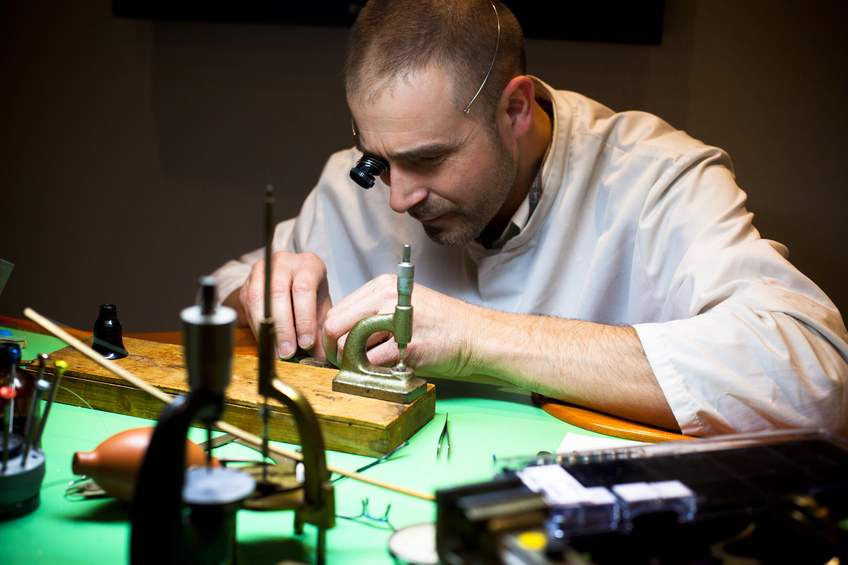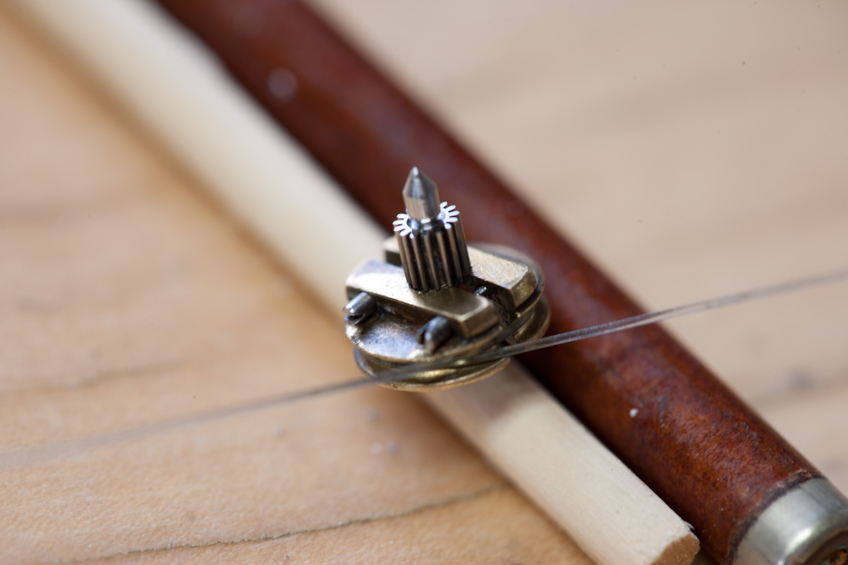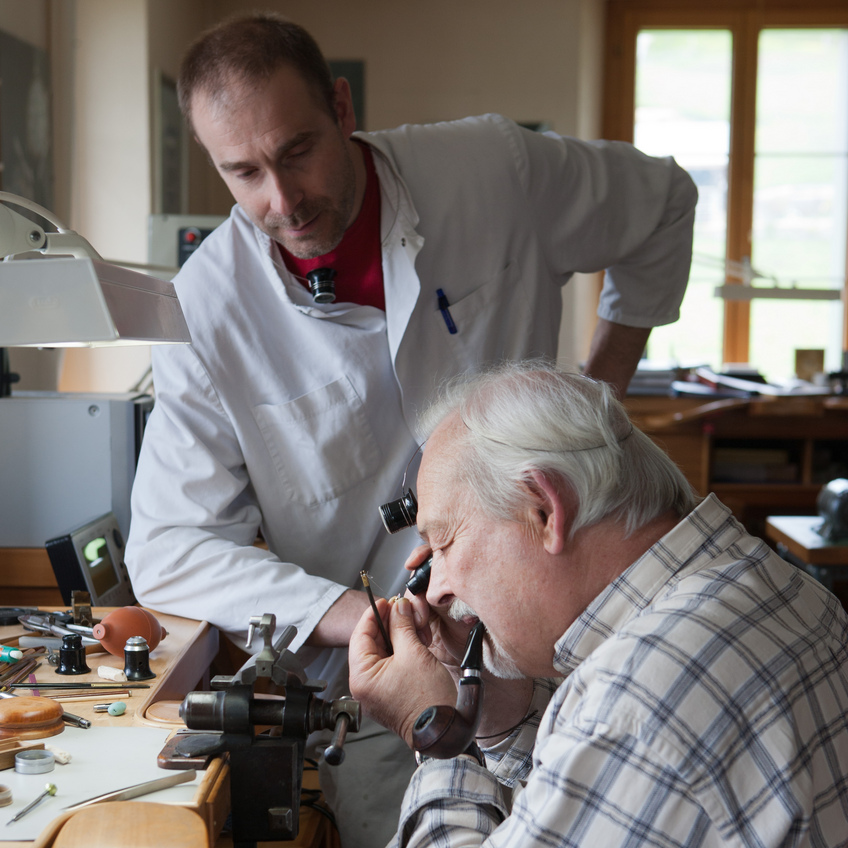

Greubel Forsey and Philippe Dufour join forces to perpetuate know-how
With the project «Le Garde Temps, Naissance d’une montre», Greubel Forsey and Philippe Dufour preserve ancestral watchmaking techniques.
From time immemorial, artists and craftsmen have not only always been careful to excel in their art but have seen to transmitting their knowledge to the younger generations. Indeed, if the creation step represents a unique means of expression for the artist, it is accompanied by a will to transmit and perpetuate the acquired knowledge. This is not only pertinent to art but to any field requiring a particular knowledge. Thus, Socrates took Plato on as disciple; Andrea del Verrochio trained Leonardo da Vinci while Joseph Haydn took it upon himself to enrich the musical education of Ludwig van Beethoven.
The list goes on and, if an explanation is required to such a phenomenon, it is imputed to the ephemeral nature of the human being. Aware that he will die one day, man often wishes making history as much as he wants to quench his thirst of the knowledge possessed by his ancestors. It is for this reason that student and master look for one another and when similar talents meet, the apprenticeship connection is created.
Modernity and tradition
In trying to measure the passing time, watchmakers have designed mechanical and precision wonders. The timekeepers manufactured for more than 500 years, are sometimes true art masterpieces and the techniques that allow such feats are the result of an exceptional craftsmanship. In the care of minutiae as well as commercial profitability, watchmakers have, throughout the years, adopted industrial methods and thus machines have replaced the human hand for certain aspects of creation. If this was a natural evolution, it also brought about a disappearance of ancestral techniques used by master watchmakers of the time as well as the necessary tools to the manufacturing.

For several years now, this established fact is a subject of worry for numerous watchmaking players. Thus, multiple brands regularly call on craftsmen to keep art professions’ know-how intact, for example. However, this is only a tiny portion of knowledge on the edge of being lost forever. In front of such an observation, Philippe Dufour together with Robert Greubel and Stephan Forsey, have pondered over a way to preserve these ancestral watchmaking traditions and have built the project: «Garde Temps, Naissance d’une Montre».
They have decided they would list as much traditional techniques used in the design of a watch as possible to teach them to a student who may then take over the task of teaching. To this end, they have chosen Michel Boulanger, a French watchmaker and watchmaking teacher who, for the duration of this project, has accepted to put his career on hold to get back into the skin of a student. Thanks to their teachings, the student will be able to create a timekeeper completely by hand, thus validating the control of the knowledge received. As it is, they have opted for the creation of a manual winding wristwatch with tourbillon complications displaying hours, minutes and seconds.
A unique approach
This project is one-of-a-kind on several grounds. Firstly, it is an approach concretely disinterested since as it uses traditional techniques to design a timekeeper at the time when machines are facilitating tools in terms of work, time and necessary costs. The operation can undoubtedly not be expected to generate profits. Secondly, because it is not a project undertaken by only one brand but by three watchmakers who wish to transmit their knowledge to a generation thirsty for knowledge. Finally, due to the fact that Michel Boulanger was chosen for the laying up of this know-how, this project is not in line with a punctual approach but rather with a transmission perspective. In fact, once the techniques are perfectly assimilated, the student will turn into a master and will take over the role of the one sharing experience.
A rocky journey
If the project has currently only been started, it is nevertheless possible to grasp its magnitude since at the first sketch,the players of this project were able to see the difficulties attached to the creation of a hand-made timekeeper.

In fact, starting from scratch for his timekeeper, Michel Boulanger self-imposed the creation of each and every element which compose it, the calculation of each parameter, and the necessary essays for the validation of each concept. Nevertheless, this learning through practice will undoubtedly allow him to fully comprehend the experience and, it will maybe kindle an interest in other watchmakers to contribute to the preservation of ancient watchmaking techniques in their way.
The project participants
Michel Boulanger was born in Jouy, at 100 km South East of Paris. Following in the steps of his father, he made his entry into the world of watchmaking and became master watchmaker at the end of his studies. He has also completed the course given by the WOSTEP on complicated watches. Afterwards, he specialised in the restoration of ancient clocks and watches before enriching his experience on modern timekeepers at Renaud & Papi. Watchmaking teacher in Paris, Michel Boulanger was the ideal student for the «Le Garde Temps, Naissance d’une montre» project.

Philippe Dufour was born, lives and works in the Vallée de Joux. He entered watchmaking school when he was 15 years old. Once he became holder of a diploma, he went to deepen his experience at Jaeger-LeCoultre. Then worked at the General Watch Co. (GWC), which occasioned the opportunity to travel to Germany, England as well as to the American Virgin Islands. Back to Switzerland, he successively worked for Gérald Genta and Audemars Piguet, brands for which he later manufactured five Grande Sonnerie pocket watches. Nevertheless, his passion for ancient watchmaking traditions led him to become an ancient watch restorer. This activity ensured him not only an unordinary experience but also stimulated the will to manufacture his own timekeepers. Thus, in 1992, he presented his Grande Sonnerie wristwatch, a world premiere. In 1996, the double escapement watch Duality was presented followed by the Simplicity model in 2000.
Born in Alsace, Robert Greubel developed a passion for horology since he was young by observing the work of his watchmaker father. Passionate of complicated movements, he moved to Switzerland in 1987 and collaborated to the IWC great complication project. As from 1990, he became a prototype specialist at Renaud & Papi, then co-director and partner. Stephen Forsey was born in St. Albans, England. As was the case for Robert Greubel, he inherited his attraction for mechanics from his father. In 1987, he specialised in the restoration of ancient clocks and became head of department in terms of watch restoration at Asprey in London, and completed his formation at the WOSTEP. In 1992, he moved to Switzerland in order to work on the most complicated movements at Renaud & Papi. There, he met Robert Greubel. In 2001, both of them founded CompliTime in 2004 and joined forces to create Greubel Forsey.
Pictures copyright: Le Garde Temps - La Naissance d'une montre. All rights reserved.


















